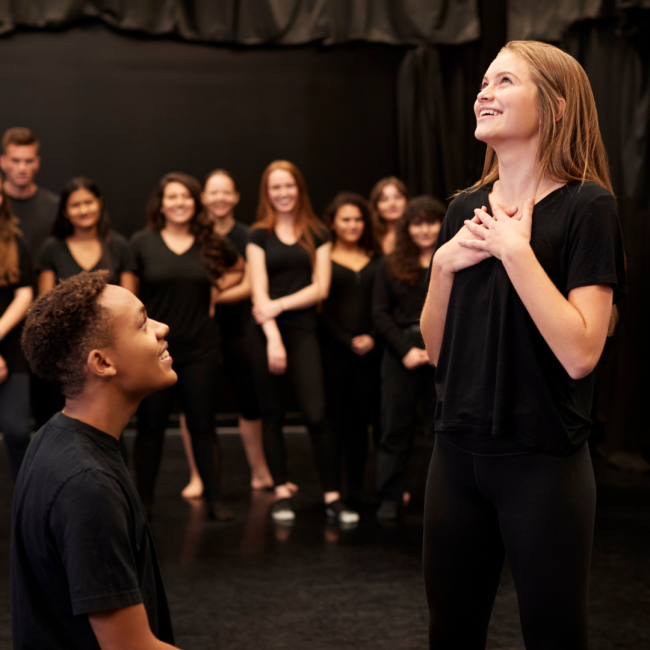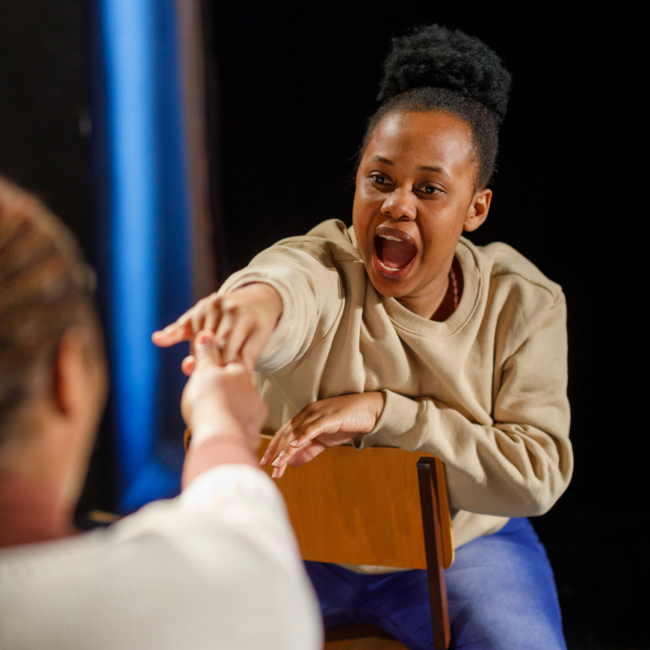What comes to mind when you hear the word ‘improv’? If you’re anything like most of the theatre people I know, it’s either pure enthusiasm or abject terror. Like “musicals versus plays”, improv is one of those dividing lines in theatre with equally fervent advocates on both sides and very little middle ground. In this blog post, I’ll tackle some of the common misconceptions about improv and share some tips on how to embrace it as a valuable acting tool.

First, let’s dispel one of the biggest myths and misconceptions about improv: that it has to be funny. Depictions of improv on TV or in movies usually portray it as inherently silly and funny, something that requires the ability to instantly come up with clever jokes. But there’s nothing that says that improv has to be funny. I think the idea that improv is essentially a marriage of acting and stand-up is what scares a lot of people. Yes, comedy and improv are inextricably linked. But being funny shouldn’t be the main focus for the improv actor. In fact, I’ve seen some deathly serious improv scenes. A serious improv scene acted truthfully is way more enthralling than a scene with forced comedy.
Now that we’ve taken the pressure of comedy out of the equation, you may wonder what improv even *is* anyway. If you’ve ever watched shows like Whose Line is it Anyway, you may think of it as silly games with rules like “you can only talk in questions”. That’s a specific form of improv called short-form improv, and it’s a valuable performance form. But at its core, improv is a pair or team of actors building a scene without a script by listening and feeding off each other’s ideas. Everything else is really just decoration. Check out this video to hear actor Jason Sudeikis describe his experience with improv.
So, how do you get good at it? Like everything, it comes down to practice, practice, practice. Get a group of friends together for a weekly or monthly improv night. Look for community theatres in your area that offer improv classes. These are low-stakes opportunities to hone your skills.
It’s also helpful to know the core “rules” of good improv, some of which you can practice in your everyday life:
"Yes, and"
The most sacrosanct rule of improv, “yes and” is simply the idea that you should always accept whatever reality your partner introduces in a scene and then build off it. If your partner says “is that a T-Rex coming towards us?”, you should accept that there is now a T-Rex in your scene and build off of that. You can practice this skill in everyday conversation. Look for opportunities to use “yes and” where you might normally say “no” or not build off of what the other person is saying.
Listen, listen, listen
Improv is all about the art of listening. You can’t be a good improv partner if you’re not actively listening to what your partner is introducing into the scene. You never know when you might be able to use even minor details like another character’s name or occupation for a punchline or to build the scene.
Find the game
Is there a pattern or recurring theme in a scene that you can use? For example, I once saw a scene where a car salesman was trying to sell a car to a skeptical woman. The salesman kept using increasingly bizarre jargon to convince the woman that this was the car for her. That became the game, and by the end of the scene the woman was trying to one-up the car salesman by using her own made-up jargon to catch him in a lie. Games give a scene some sense of structure and a framework to fall back on.
Heighten
To heighten something means to take the game of the scene or a character trait and make it more exaggerated or outrageous. If your character is afraid of spiders, you can heighten it by making them increasingly afraid of anything that remotely resembles a spider. Or by introducing spiders into the scene in increasingly bizarre ways. Maybe the scene is about a husband and wife arguing over dinner. They could go back and forth between calm and arguing over increasingly mundane things with increasing hostility. These are basic examples of heightening in an improv scene. Heightening can be fuel for your scene-you still need to drive it, but it’s there to push you along.

Finally, if nothing else, improv can be a useful rehearsal tool for discovering new aspects of your character and new dynamics to their relationship with other characters in a scene. One of my favorite tricks when I feel like I’m in a rehearsal rut is to take the characters out of the context of the play and see what happens. What happens when Willie and Biff Loman go out for burgers together? What new dimensions could you find in the relationships between the characters in August: Osage County if you transplant them to a spaceship on the way to Jupiter? It might get silly, but it’s a good way to get out of your head and allow the characters to live organically in totally new ways..
Improv can be scary, but it doesn’t have to be! Give it a try sometime and see where it takes you.
Last Updated: October 30, 2023

Kevan Dunkelberg
Oklahoma-based drama teacher, actor and playwright